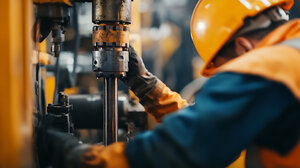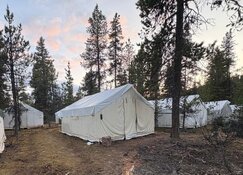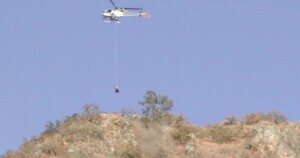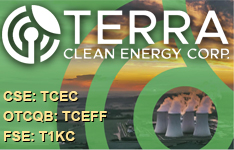Anthony Mariano: Beach sand and river placer monazite occurs in plentiful supply in many countries outside of China. The rare earth oxide (REO) content of monazite is approximately 70 weight percent (wt%) and the distribution has a better intermediate REE content than bastnasite. Bastnasite is the world's source at this time, and has been historically, for the light rare earth elements (LREEs).
TCMR: If this type of sand deposit is available, why aren't companies considering it?
AM: The current perceived challenge to mining monazite is the presence of thorium in the structure. If the thorium disposal problem can be solved economically, monazite mining can provide all of the necessary light and medium atomic number REEs to the marketplace without dependence on China.
Thorium can be controlled, but if the public doesn't understand this, it's going to be very difficult to start any mining operation in which the mineral has a substantial amount of thorium in its structure. When Molycorp Inc. (MCP:NYSE) and Rhône-Poulenc, which is now Rhodia RGPT (RHA.PA), were providing the bulk of the REEs to the marketplace, Rhône-Poulenc received all of its REEs from beach sands in Australia and South Africa. It transported the monazite sands to France and eventually compiled an unusual quantity of thorium. The French government forbade the company from continuing this, so it switched over to bastnasite and left the monazite. The physical and chemical processing of monazite is well-known and can be handled, but the problem is what to do with the thorium after it is extracted.
TCMR: Are scientists and companies considering launching these types of projects, which will exploit the REE potential of monazite, while economically handling the thorium?
AM: Yes, Medallion Resources Ltd. (MDL:TSX.V; MLLOF:OTCQX) is one of them. Mining Ventures Brasil Ltda., a private company, is another one.
TCMR: Is the case for mining monazite sands strengthened by the fact that a lot of the processing has already occurred from natural crushing, assuming the thorium can be handled?
AM: Yes. In mining hard rock, crushing represents 61% of the cost. Virtually no crushing is involved in mining beach sands. And there are large monazite tailings from existing beach sand mining operations, which are available for exploitation.
TCMR: So most of these deposits are near large bodies of water, which has a potential for shipping and infrastructure advantage. Where are some of these large monazite sand deposits located?
AM: All over the world. They occur extensively in Africa, South America, Australia and in various parts of North America. Beach sands have been mined in North and South Carolina over the years, but a lot of these areas are now residential, which presents problems.
TCMR: So the monazite sands that now look like opportunities for REE extraction would have to be in relatively remote places. Would you like to discuss eudialyte now?
AM: Eudialyte is an attractive, potential source of heavy rare earth elements (HREEs). The name eudialyte is taken from the Greek and means "easily dissolved." In composition, it is a complex sodium calcium zirconosilicate that can include substantial HREEs. Active exploration for acceptable grade and tonnage is happening in Kipawa, Quebec and at Nora Kärr, in Sweden.
TCMR: Kipawa is the project by Matamec Explorations Inc. (MAT:TSX.V; MRHEF:OTCQX), correct?
AM: Yes, and Norra Kärr is Tasman Metals Ltd.'s (TSM:TSX.V; TAS:NYSE.A; TASXF:OTCPK; T61:FSE) project. In these two areas, the HREE in eudialyte ranges approximately 4–7wt%. Despite the high solubility of eudialyte in weak acids, the isolation of zirconium silicate, yttrium oxide and the REOs from the resultant solutions have resisted the separation of intimately associated silica gels. That's been the problem. Matamec and Tasman are experimenting in the economic chemical processing of eudialyte and making innovative progress.
TCMR: Are these deposits very large?
AM: Some of them are quite substantial, in excess of 10 million tons (Mt) of >0.1 wt% REO. Eudialyte in these deposits would be 4–7wt% REE substituting in the eudialyte structure.
TCMR: Do you see monazite sands and eudialyte as potential game changers in REEs?
AM: Yes, I see that in both monazite beach sands and eudialyte. Another related type of deposit occurs in Brazil in river and streambeds.
Mining Ventures Brasil is in full swing with an exploration program in central Goiás, Brazil, for REE-bearing heavy minerals in colluvium, which is loose mineral and rock debris derived from weathered rocks.
It occurs along streams, not beach sands, and it's not eudialyte, but it can be monazite. The heavy minerals include xenotime—a heavy lanthanide-enriched mineral—and monazite as liberated grains that are readily amenable to physical processing. Both xenotime and monazite are enriched in HREEs, and the technology for the chemical processing of these two minerals is well established.
TCMR: Is this an inland deposit in Brazil?
AM: Yes, the REE-bearing colluvium covers 25 x 50 kilometers (km), and the REE grade runs at approximately 0.6wt%. This type of mineralization can be mined by dredging operations similar to beach sands and river placer mining.
TCMR: Have you visited this?
AM: I've made three missions there. One of them was when it was initially starting, and I'll be going back in January.
TCMR: Are these deposits along the Amazon?
AM: No, they are located in central Brazil, brush country.
TCMR: In terms of development, what stage is Mining Ventures Brasil in?
AM: It's heavily involved in establishing the grade and tonnage on a large scale. It will soon be doing pilot-plant testing in Brazil.
TCMR: Very interesting. Most REE explorers today are seeking rare earths in carbonatite host structures, correct?
AM: Yes. A carbonatite is an igneous rock of mantle origin that comes from deep below the crust, a depth of about 50km in the upper mantle. When the magmas in that area come up, they may be more than 50% carbonate or dolomite, which makes them carbonatite.
Coming from the mantle, they can also carry an exotic quantity of high field strength elements, or other valuable elements. All carbonatites are anomalous in rare earth elements, but in most cases they are not amenable to recovery.
TCMR: Because of the depth?
AM: No, because of the nature of the mineralization. In carbonatites, calcite and dolomite can be totally broken down, and the minerals that resist solution become concentrated. When this happens, both calcite and dolomite, and even the mineral apatite, which contains small quantities of REEs in their structure, are broken down. The rare earths are then liberated, and supergene rare earth minerals can evolve due to lateritic weathering of carbonatite on an impressive scale.
This is the origin of Lynas Corp.'s (LYC:ASX) Mount Weld rare earth mineralization. It also occurs in a few other parts of the world where the logistics may be very promising and where the grade and tonnage are excellent. However, processing will require an innovation. The secondary supergene rare earth minerals are submicron in size, so they resist physical concentration.
TCMR: Thank you for your insights, Dr. Mariano.
Anthony N. (Tony) Mariano, Ph.D., is a geological consultant on rare earths and other rare metals. For decades, he has been the "go-to" expert on the geology and mineralogy on rare earths, niobium-tantalum and other rare metals. Companies around the world depend on his professional opinions on the potential economic viability of deposits based on mineralogical examination, lab work and field visits.
Want to read more exclusive Critical Metals Report articles like this? Sign up for our free e-newsletter, and you'll learn when new articles have been published. To see a list of recent interviews with industry analysts and commentators and learn more about critical metals companies, visit our Critical Metals Report page.
DISCLOSURE:
1) Sally Lowder of The Critical Metals Report conducted this interview. She personally and/or her family own shares of the following companies mentioned in this interview: None.
2) The following companies mentioned in the interview are sponsors of The Critical Metals Report: Matamec Explorations Inc., Medallion Resources Ltd. and Tasman Metals Ltd. Streetwise Reports does not accept stock in exchange for services.
3) Anthony Mariano: I personally and/or my family own shares of the following companies mentioned in this interview: None. I personally and/or my family am paid by the following companies mentioned in this interview: None. Dr. Anthony Mariano was not paid by Streetwise for participating in this story.
Dr. Anthony Mariano has an "at request" consulting relationship with several of the listed companies.






































